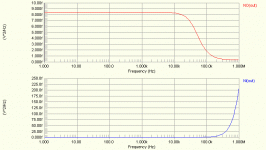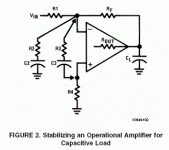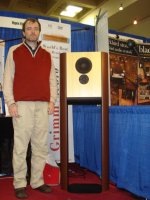Noise gain is indeed related to stability. If we read Bob Pease' (Troubleshooting Analog Circuits page 100, National LB-42, http://electronicdesign.com/Articles/Index.cfm?AD=1&ArticleID=7164 ) usage of noise gain, it is used for stabilisation.Stability.
Imagine an opamp with inverting and non-inverting input.
There is one stabilisation method where we can put a resistor from inverting input to ground or from inverting input to non-inverting input. This method actually altering the noise gain without altering the frequency response of the whole system, for having stability.
Attachments
Mr. Curl,
My question is, can noise gain curve and group delay curve be a guidance for a good sounding amp?
My question is, can noise gain curve and group delay curve be a guidance for a good sounding amp?
lumanauw said:Mr. Curl,
My question is, can noise gain curve and group delay curve be a guidance for a good sounding amp?
Not sufficient.
This is an interesting, but difficult to get any real info from approach. I would stick to either stability evaluation or settling time, as it is more direct.
Hi, Mr. Curl,
I really interested in the importance of Group Delay for audio reproduction gear. Bruno Putzey somewhere had wrote this.
From http://en.wikipedia.org/wiki/Group_delay I read that group delay is transit time/frequency, best is constant in <20khz.
I really interested in the importance of Group Delay for audio reproduction gear. Bruno Putzey somewhere had wrote this.
From http://en.wikipedia.org/wiki/Group_delay I read that group delay is transit time/frequency, best is constant in <20khz.
You cannot overemphasize one single parameter. This needs to study signal transfer theory, and explanation is behind diyforum limits.
Okay 😉 . If I may ask, why there is a different additional resistor loading in OUT+ and OUT- of the Halo JC-2. 2k2 + 500R pot in +OUT, 10k in -OUT. Why there is that additional loading at all. To get defined minimum load current? To balance for THX?
That is an interesting problem that we first found with the JC-80. It has to do with the A+1 output from the positive out compared to just A on the negative out. If you do NOT use balanced input drive, you must attenuate the positive out a little to balance the output with the negative out. It cannot be a fixed attenuation, if you have a choice of balanced and unbalanced inputs, because the attenuation is unnecessary with balanced input. The CTC Blowtorch, although based on the same design principles, does not need this gain adjustment, because it does not use global feedback.
lumanauw said:Hi, Mr. Curl,
I really interested in the importance of Group Delay for audio reproduction gear. Bruno Putzey somewhere had wrote this.
From http://en.wikipedia.org/wiki/Group_delay I read that group delay is transit time/frequency, best is constant in <20khz.
You can ask Bruno here... 😉
Jan Didden
Attachments
- Status
- Not open for further replies.
- Home
- Amplifiers
- Solid State
- John Curl's Blowtorch preamplifier


